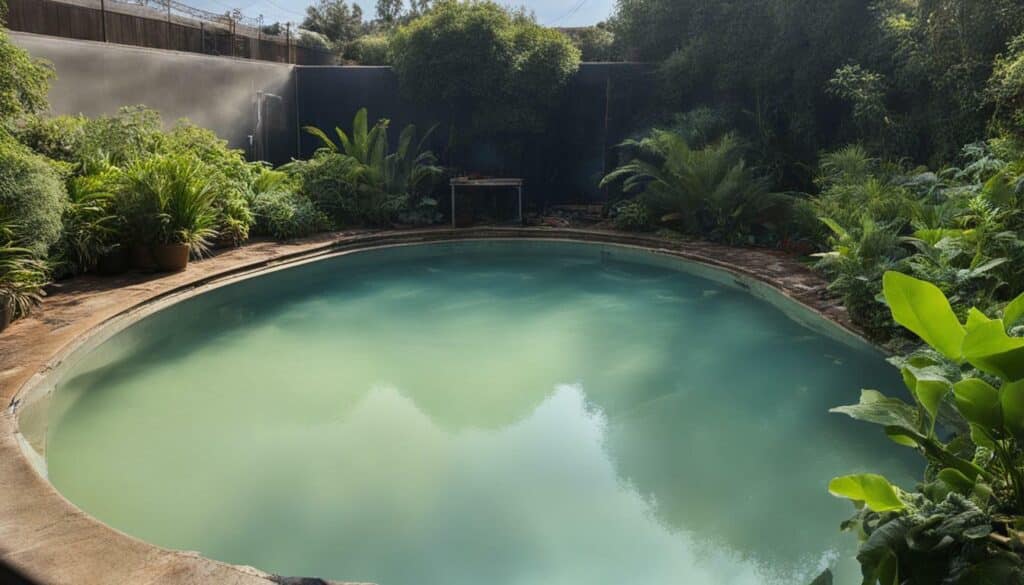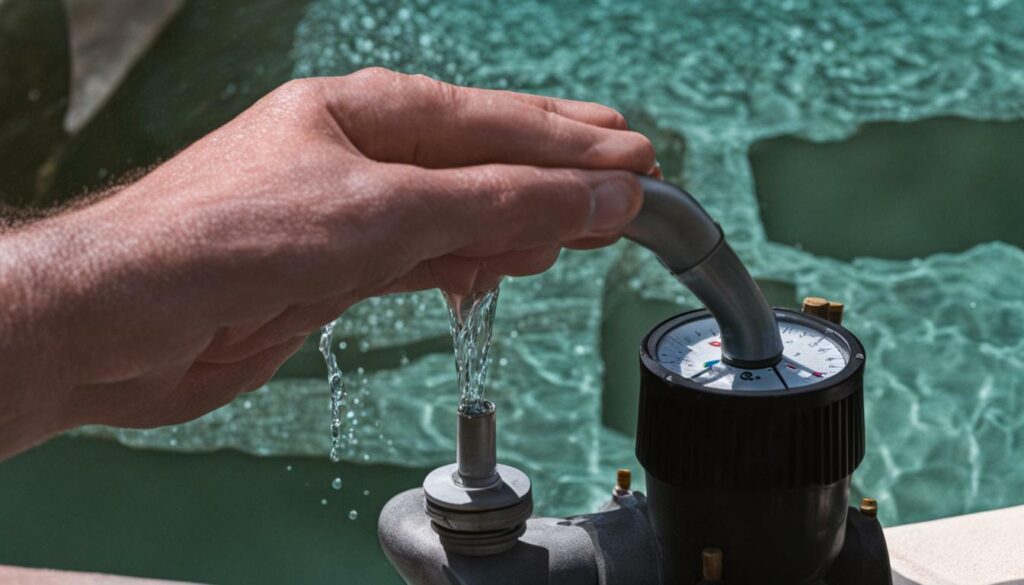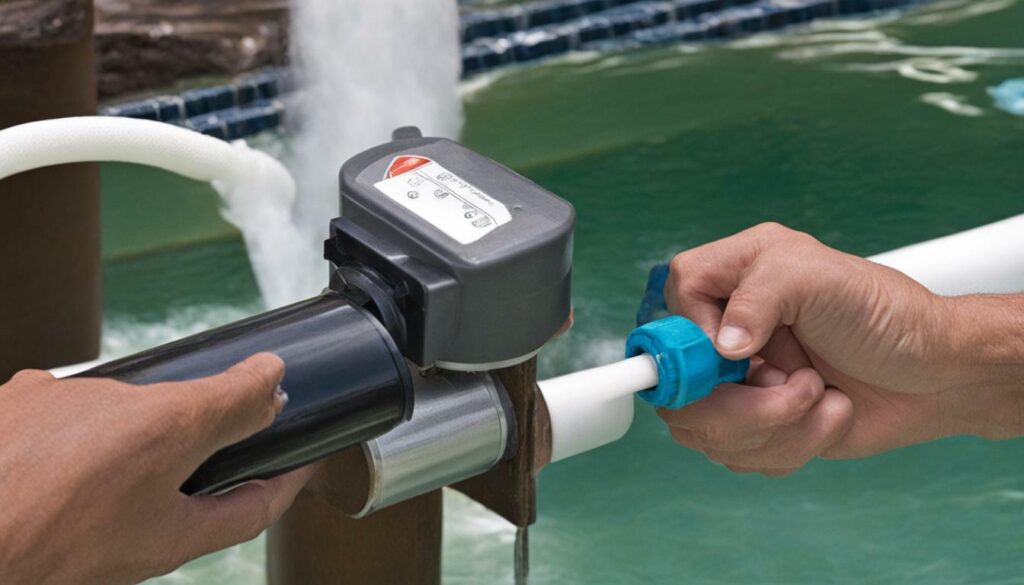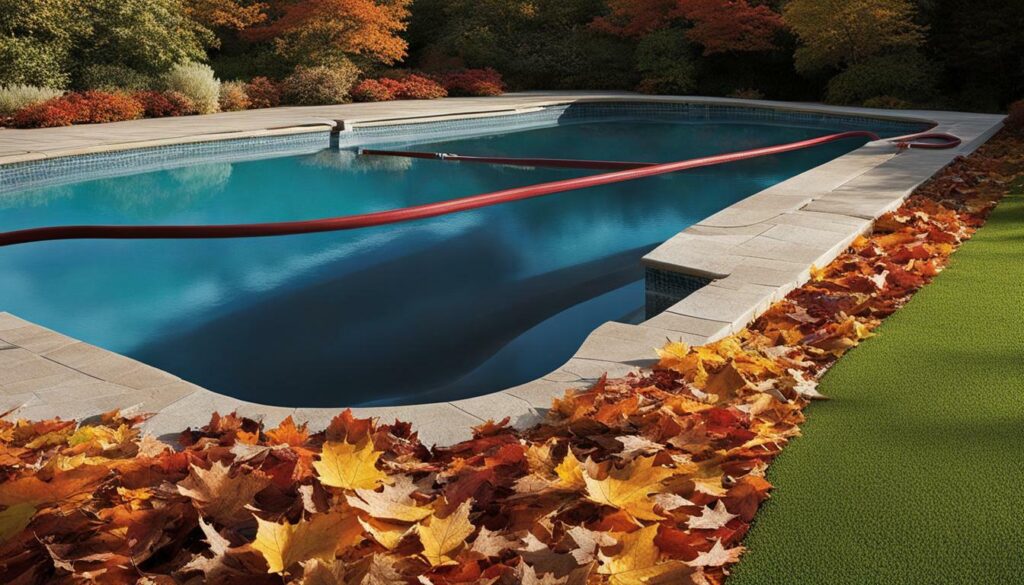
Keeping your pool clean and clear is essential for a healthy swimming environment. One of the most important maintenance tasks is vacuuming, and using a sand filter can make the process even more effective. In this section, we’ll guide you through the steps of vacuuming your pool with a sand filter, ensuring your pool stays sparkling clean.
- Vacuuming your pool is essential for a healthy swimming environment.
- A sand filter can make the vacuuming process even more effective.
- Following the proper steps and maintaining the sand filter regularly will ensure your pool stays clean and clear.
- Preparing the pool, connecting the vacuum hose, operating the sand filter, and cleaning the sand filter are all important steps in the vacuuming process.
- Don’t forget to finish with some maintenance tips and best practices to extend the life of your sand filter.
Understanding the Sand Filter System
Before starting the pool vacuuming process, it’s important to understand how the sand filter system works. The sand filter is a vital component of your pool’s maintenance system that ensures crystal-clear water all season long. It works by trapping dirt, debris, and other impurities in the sand bed while allowing the water to flow through the filter.
The sand filter system consists of three main components:
| Component | Description |
|---|---|
| Filter Tank | This is the main body of the filter that holds the sand bed. |
| Multiport Valve | This valve controls the flow of water through the filter and allows for different operating modes. |
| Pressure Gauge | The pressure gauge indicates the level of pressure in the filter, which can help determine when it’s time to clean or backwash the sand bed. |
Pool maintenance with sand filter requires you to check the pressure gauge regularly and backwash the filter as needed. Backwashing involves reversing the water flow through the filter to flush out any trapped debris and restore the filter’s efficiency.
How the Sand Filter System Works
Water from the pool is pumped through the main drain and skimmer into the filter tank. The water then flows through the sand bed, which traps any debris and impurities. Clean water is then returned to the pool through the return jets. Over time, the sand bed becomes clogged with debris, which can increase the pressure in the filter and reduce its effectiveness.
When this happens, it’s time to backwash the filter. This process involves reversing the water flow, which flushes out any trapped debris and sends it to the waste line. Once the backwashing process is complete, the multiport valve is set back to the filtration position, and the sand bed is once again ready to trap debris and impurities.
Understanding the basics of the sand filter system is essential for proper pool maintenance with sand filter. In the next section, we’ll walk you through the steps to prepare your pool for effective vacuuming.
Preparing the Pool for Vacuuming
Before you start vacuuming your pool with a sand filter, it’s important to do a few preparations. Following these steps will ensure your pool is ready for optimal cleaning.
First, clean the pool surface of any debris like leaves or dirt using a manual pool skimmer or a net skimmer attachment on a pool pole. This will prevent these contaminants from clogging the sand filter during the vacuuming process.
Next, check the water level of your pool. The water level should be at the mid-point of your pool skimmer’s opening. If the water level is too low, add water to the pool using a garden hose. If the water level is too high, use a submersible pump to drain the excess water.
Ensuring that the pool skimmer is clear of debris is also critical. The skimmer is responsible for trapping larger debris like leaves and twigs, which would otherwise clog the sand filter. If the skimmer basket is full, empty it before starting the vacuuming process.
By taking these straightforward steps, you will ensure that your pool is ready for effective vacuuming. Now that you’ve prepared your pool, it’s time to move on to the next step of connecting the vacuum hose.
Connecting the Vacuum Hose
Now that you have prepared your pool for vacuuming, it’s time to connect the vacuum hose to the pool’s skimmer or a dedicated vacuum line. Here’s how:
- Prepare the hose: First, remove any air from the vacuum hose by placing one end of the hose in the pool and filling it with water until the other end of the hose is submerged.
- Attach the hose to the skimmer: If you’re using the skimmer method, remove the skimmer basket and place the vacuum plate over the skimmer hole. Next, insert the hose through the vacuum plate and into the skimmer hole. The hose should fit snugly in the hole.
- Attach the hose to the vacuum line: If you’re using the dedicated vacuum line, locate the vacuum port on the side of the pool. Remove the cover and attach the hose to the port using a vacuum adapter.
- Check for leaks: Once you’ve connected the hose, check for any leaks around the connection points. Any leaks could affect the suction power of the vacuum and hinder its performance.
Make sure the vacuum hose is long enough to reach all areas of the pool without coming out of the skimmer or vacuum port. If your hose is not long enough, you can connect additional hoses to extend its length. Once the hose is connected properly, you’re ready to start vacuuming your pool.
Operating the Sand Filter
Before you start vacuuming, it’s important to understand the settings and operation of the sand filter system in order to achieve effective pool vacuuming.
The first step is to adjust the valve positions. Turn the multiport valve handle to the “Filter” position to allow water to flow from the pool to the sand filter. If there is a separate suction line for the vacuum, you need to divert the water flow to this line using the valve.
Next, set the filter on the proper filtration mode. For simple debris like leaves and dirt, the “Filter” mode is the best option. For more challenging dirt and debris, such as algae, use the “Waste” or “Backwash” mode.
Remember to start the vacuum with a clean sand filter. A dirty filter will not allow water to pass through, reducing the effectiveness of the vacuuming process.
If the pressure gauge indicates a pressure rise of 8-10 psi, it’s time to clean the filter. In this case, backwash the filter using the multiport valve and rinse it afterward. A clean filter ensures a good water flow for effective vacuuming.
Once you have completed the vacuuming, turn off the pump and set the multiport handle to “Closed” or “Winterize.” This will prevent any water from entering the filter and causing frost damage during the winter.
Remember, regular cleaning and maintenance of your sand filter are essential for optimal performance.
Vacuuming the Pool
Now that you have properly connected the vacuum hose and adjusted the sand filter settings, it’s time to begin vacuuming your pool. Start by slowly moving the vacuum head along the pool floor, working in overlapping rows to ensure all areas are covered.
As you vacuum, be sure to keep an eye on the pressure gauge on your sand filter. If the pressure rises above the recommended level, it may be necessary to backwash the sand filter before continuing.
When vacuuming the walls of your pool, attach the brush attachment to the vacuum hose to scrub away any stubborn debris.
It’s important to take your time when vacuuming to ensure thorough cleaning of the pool. If you rush the process, you may miss areas that can lead to algae growth and other issues.
Once you have finished vacuuming, carefully disconnect the vacuum hose from the skimmer or dedicated vacuum line and clean any leftover debris.
Remember, regular vacuuming is essential for maintaining a clean and healthy pool. Aim to vacuum your pool at least once a week, or more frequently during periods of heavy use or when there is a lot of debris in the pool.
Cleaning the Sand Filter
Regular maintenance of the sand filter is essential to ensure its longevity and optimal performance in vacuuming your pool. Over time, the sand in the filter can become clogged with debris and contaminants, reducing its effectiveness in cleaning the pool water. Here’s how to clean your sand filter:
- Backwash the filter: The first step in cleaning the sand filter is to backwash it. This process involves reversing the flow of water through the filter, flushing out any debris and contaminants. To backwash the filter, set the valve to the “backwash” position and turn on the pump. Let the water run for 2-3 minutes or until the water in the sight glass is clear.
- Rinse: After backwashing, switch the valve to the “rinse” position. This will clear out any remaining debris and ensure the sand is settled back into position.
- Clean the filter: Once the rinse cycle is complete, turn off the pump and remove the filter’s lid. Use a garden hose to rinse off the sand and clean out any remaining debris. Be careful not to damage the filter’s collector arms or laterals.
- Replace the sand: If the sand in the filter is more than five years old or has become excessively dirty, it may need to be replaced. Consult the manufacturer’s instructions for the correct amount of sand to use and the proper installation procedure.
By cleaning your sand filter regularly and following the manufacturer’s instructions for maintenance, you can ensure that it operates efficiently, keeping your pool water clean and clear for years to come.
After vacuuming your pool, there are a few additional steps you can take to keep it in top condition. Regular pool maintenance with your sand filter will extend the life of your system and keep your pool crystal clear.
Tip #1: Test and Balance Your Pool Water
Regularly test your pool water to ensure it’s balanced with the appropriate levels of chlorine, pH, and alkalinity. If levels are off, adjust accordingly to prevent algae growth and other issues.
Tip #2: Brush Your Pool Walls and Floor
Brushing your pool walls and floor regularly will help loosen any debris or algae build-up. This makes it easier to vacuum and ensures optimal filtration with your sand filter.
Tip #3: Monitor Your Sand Filter Pressure
Periodically check your sand filter pressure gauge to ensure it’s functioning correctly. If the pressure is too high, you may need to backwash your filter. If it’s too low, it may be time to replace your sand.
Tip #4: Backwash Your Sand Filter Regularly
Backwashing your sand filter regularly (usually every few weeks) removes any trapped debris and helps restore the filter’s efficiency. Follow the manufacturer’s instructions for your specific sand filter model.
Tip #5: Schedule Professional Maintenance
Even with regular maintenance, it’s a good idea to schedule professional pool maintenance at least once a season. They can perform a thorough cleaning and inspection of your sand filter system to ensure it’s working at optimal levels.
Following these tips and regularly maintaining your sand filter will keep your pool looking great and functioning efficiently for years to come.
Conclusion
By following these simple steps, you can easily vacuum your pool using a sand filter. Regular maintenance of the sand filter is essential to ensure its optimal performance. Remember to clean the sand filter regularly and backwash when needed.
Additionally, keeping your pool clean requires ongoing maintenance. Ensure that you keep the pool water balanced, skim debris from the surface regularly, and brush the walls and floor to prevent algae buildup.
With these tips in mind, you can enjoy a sparkling clean pool all year round without having to hire a professional. We hope you found this guide helpful in learning how to vacuum your pool with a sand filter. Happy pool cleaning!
FAQ
Q: How often should I vacuum my pool with a sand filter?
A: It is recommended to vacuum your pool once a week to remove debris and keep the water clean.
Q: Can I use a sand filter to vacuum an above-ground pool?
A: Yes, you can use a sand filter to vacuum an above-ground pool. The process is the same as vacuuming an in-ground pool.
Q: How long should I run the sand filter after vacuuming the pool?
A: It is recommended to run the sand filter for at least 8 hours after vacuuming to ensure proper filtration and circulation of the water.
Q: Do I need to backwash the sand filter before vacuuming?
A: It is a good practice to backwash the sand filter before vacuuming to remove any trapped debris and improve its efficiency.
Q: Can I use a manual vacuum or do I need an automatic pool cleaner?
A: You can use a manual vacuum with a sand filter to effectively clean your pool. However, an automatic pool cleaner can provide convenience and save time.
Q: How do I know if my sand filter needs cleaning?
A: If you notice a decrease in water flow or pressure coming from the filter system, it may be time to clean the sand filter. Additionally, regular maintenance is recommended every 6-12 months.
Q: Can I vacuum the pool while people are swimming?
A: It is not recommended to vacuum the pool while people are swimming for safety reasons. Ensure the pool area is clear before starting the vacuuming process.
Q: Should I remove large debris manually before vacuuming?
A: Yes, it is advisable to remove large debris manually using a pool skimmer or net before starting the vacuuming process. This will prevent clogging and prolong the life of your sand filter.













